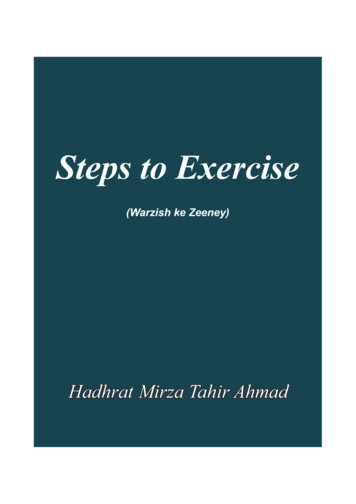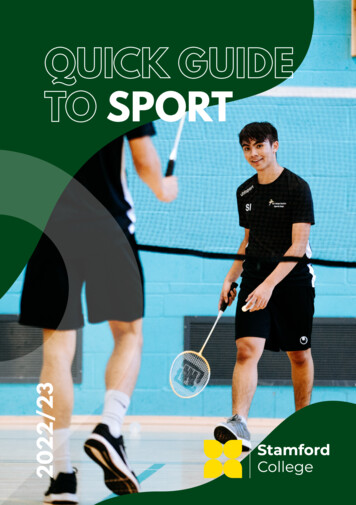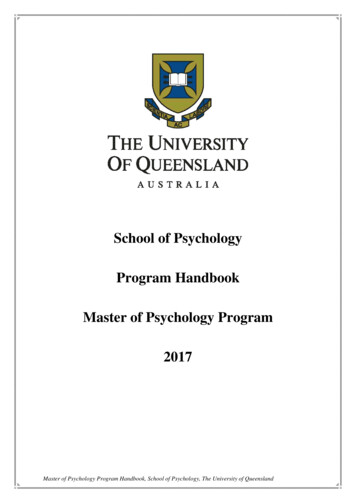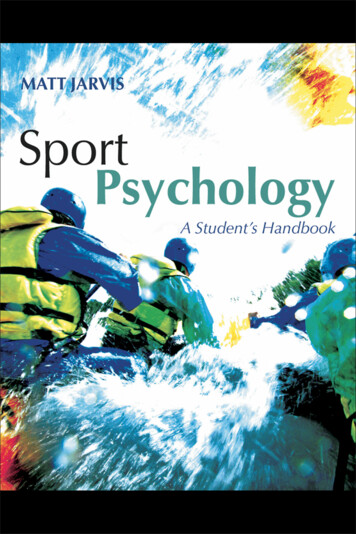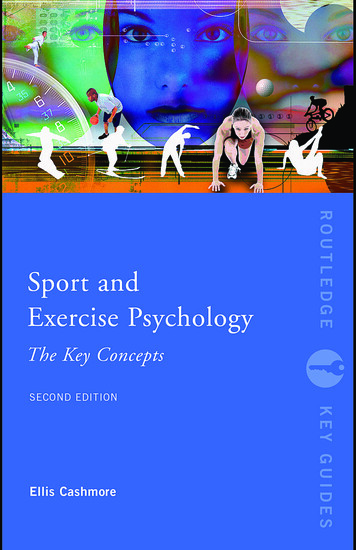
Transcription
S P O RT AN D E X E R C I S E P S Y C H O L O G YPraise for the first edition:‘‘The exploration of the concepts is concise; the writing style is engagingand easily understandable without being patronising or simplistic . . . auseful reference tool, a quick and user-friendly resource to be used toinform discussion, or [as] a source of illumination.’’Higher Education Academy Psychology NetworkNow including exercise psychology terms for the first time in its newedition, Sport and Exercise Psychology: The Key Concepts offers a highlyaccessible introduction to this fascinating subject, its central theories andstate-of-the-art research. Over 300 alphabetically ordered entries coversuch diverse terms as: adherenceaggressionemotionexercise dependencehome irementself-confidence.Cross-referenced, with suggestions for further reading and a full index,this Key Guide contains invaluable advice on the psychology of sport andexercise. A comprehensive A–Z guide to a fast-moving field of inquiry,this book is an essential resource for scholars, coaches, trainers, journalists,competitors, exercisers—in fact, anyone associated with sport and exercise.Ellis Cashmore is Professor of Culture, Media and Sport at Staffordshire University, UK, and author of Making Sense of Sports as well asbiographies, such as Beckham and Tyson: Nurture of the Beast.
ALSO AVAILABLE FROM ROUTLEDGEFifty Key Thinkers in PsychologyNoel Sheehy978-0-415-16775-8Psycholinguistics: The Key ConceptsJohn Field978-0-415-25891-3
SPORT AND EXERCISEPSYCHOLOGYThe Key ConceptsSecond EditionEllis Cashmore
First published 2002This edition published 2008by Routledge2 Park Square, Milton Park, Abingdon, Oxon OX14 4RNSimultaneously published in the USA and Canadaby Routledge270 Madison Ave, New York, NY10016Routledge is an imprint of the Taylor & Francis Group, an informa businessThis edition published in the Taylor & Francis e-Library, 2008.“To purchase your own copy of this or any of Taylor & Francis or Routledge’scollection of thousands of eBooks please go to www.eBookstore.tandf.co.uk.”# 2002, 2008 Ellis CashmoreAll rights reserved. No part of this book may be reprinted or reproduced or used in anyform or by any electronic, mechanical, or other means, now known or hereafter invented,including photocopying and recording, or in any information storage or retrieval system,without permission in writing from the publishers.British Library Cataloguing in Publication DataA catalogue record for this book is available from the British LibraryLibrary of Congress Cataloging in Publication DataCashmore, Ernest.Sport & exercise psychology : the key concepts / Ellis Cashmore.p. cm. — (Key guides)Rev. ed. of: Sport psychology. 2002.Includes bibliographical references and index.1. Sports—Psychological aspects—Encyclopedias. 2. Exercise—Psychological aspects—Encyclopedias. I. Cashmore, Ernest. Sportpsychology. II. Title. III. Title: Sport and exercise psychology.GV706.4.C39 2008796.0103—dc222007044039ISBN 0-203-92809-1 Master e-book ISBNISBN10: 0-415-43865-9 (hbk)ISBN10: 0-415-43866-7 (pbk)ISBN10: 0-203-92809-1 (ebk)ISBN13: 978-0-415-43865-0 (hbk)ISBN13: 978-0-415-43866-7 (pbk)ISBN13: 978-0-203-92809-7 (ebk)
CONTENTSList of Key ConceptsIntroductionvixKEY CONCEPTS1Index489v
LIST OF KEY CONCEPTSBem sex role inventorybinocular rivalrybiofeedbackbody dissatisfactionbody imagebody languagebody mass indexbody shamebrainwavesbulimia nervosaburnoutcatastrophe hokecoach–athlete relationshipcognitioncognitive-behavioral modificationcognitive evaluation theorycognitive load theory ceptconcordanceabilityachievement goal theoryachievement motiveaction controladherenceadrenaline sagingalcoholismandrogynyangeranger managementanorexia athleticaanorexia nervosaANOVAanxietyapplied sport psychologyapproacharousalassertivenessathletic utonomic nervous system(ANS)autotelicavoidancevi
LIST OF KEY CONCEPTSeye movementfansfearfear of failurefear of dergender verificationgiftednessgoalgoal orientationgoal settinggroup dynamicshalo effectHawthorne effect, thehedonic toneheuristicshome advantagehooliganismhopehypnosisiceberg profileidentificationidentified regulationidentityidiographicimageryimpostor phenomenonincentiveindividual zones of optimalfunctioning (IZOF)information processinginjuryinstinctintegrated tcontextcontrolcoping strategiescorrelationcovariation principleculturedeath wishdecision-makingdefensive attributiondeliberate practicedependencedepressiondepth gsdysphoriaeating tional controlemotional intelligenceemotional toneendorphinsequalityethicseustressexecutive controlexercise behaviorexercise dependenceexercise identityexercise motivationexpectancyexpertiseextreme sportsextrinsic motivationvii
LIST OF KEY ning syndromepainparalysis by analysisparametersparasocial interactionparticipation motivationpeak performancepeer leadershipperceptionperfectionismperformance enhancementperipheral nervous systempersonalitypersonality assessmentpersonality disorderphenomenonphysical self-perceptionsphysical self-worthpositive affectpracticepregnancyPremack principlepreperformance routinesprofile of mood states l skills inventoriespsychological skills trainingpsychopathologyracereaction izationinterpersonal relationshipinterventionintrinsic obiakinesthesiaknowledge of resultsleadershiplearned helplessnessleft-handednesslife courselocus of controlluckMANOVAmasterymastery climatemeditationmemorymental health modelmental practicemental tivationmimesismind attributionmodelmodelingmomentummoodmoral atmospheremotivationmotivational climatemotor reactionmuscle dysmorphianegativitynervous systemnervousnessviii
LIST OF KEY CONCEPTSslumpsocial facilitationsocial loafingsocial physique anxietysocializationsociotropystereotypestereotype threatstimulusstreaksstressstress-inoculation trainingstress-management trainingsuperstitious behaviortalenttask/ego orientationteam playertelic dominancetemperamenttheorytheory of planned behaviortherapytransactional leadershiptransformational leadershiptransgenderedtranssexualtranstheoretical model2 2 achievement goalframeworkType Avicarious agencyviolencevisual perceptionvisuomotorweight controlwell-beingYerkes-Dodson igionREMresponseretirementreversal theoryrewardRingelmann effect, theriskrivalryrole tion f-fulfilling gself-regulationself-serving biasself-talksensation-seekingsexsex testsex typingsibling rivalryskillskill acquisitionskill executionsleepix
INTRODUCTIONWhat do we need to know aboutusing this book?This book is like a supermarket cart after a twenty-minute journeyaround the aisles: brimming with all manner of assorted products,some essential, others minor extravagancies, but all of which will getused at some point. Like the consumables from the supermarket, thecontents of this book will not be enough to get the shopper throughthe whole week, and visits to other, more specialist stores will beneeded. But there will be enough staples to get started, and many ofthe goods will be kept in the fridge and used at a later stage.PurposeThe purpose of the book is quite simple: to provide a working A–Zof the key concepts in sport and exercise psychology. Why working?Because this reference source is not intended to sit on a bookshelfwaiting in abeyance to be consulted every so often. It’s meant to becarried around in a bag or a case, consulted daily, scrawled withhandwritten notes and daubed with highlighter. Within six monthsof purchase, it should be dog-eared, battered and plastered with thosePost-it index stickers. In other words, it’s meant to earn its keep.OrganizationThe shopping-cart metaphor works to an extent, though, of course,no one insists on arranging their goods on the check-out belt inalphabetical order: apples, aromatic candles, avocadoes, beer, burgers,and so on. Since this is a reference book, the alphabet offers a logicalsystem of organizing the material, though this isn’t quite as straightforward as it seems. For example, where does ‘‘EXERCISE IDENTITY’’go? Under ‘‘E,’’ or under ‘‘IDENTITY,’’ with a subhead exercise? Ordrugs? Should it be dope, DOPING, or even performance-enhancingx
INTRODUCTIONdrugs? And how about state anxiety? (Terms in SMALL CAPITALS havean entry of their own in the main text, by the way.)My guide has been common sense. Exercise identity appears under‘‘E,’’ and there is an entry on DOPING, with a dummy entry for drugs.Dummy entries are signpost entries: They direct the reader toanother or sometimes several other entries where the term is discussed and where its meaning will become evident. In the interests ofprecision, I have added a crisp usually one-sentence definition ofwhat the term, in its most basic sense, means. The reader can thenmove to the other entries. State anxiety is subsumed under ANXIETYbut reoccurs elsewhere, as a glance at the index will show. Similarly,sport commitment appears under COMMITMENT, so generic entriesshould be checked first.Obviously, my central task has been to compile a book where allthe key concepts in sport and exercise psychology are defined, but,even then, there may be some terms the reader can’t find in the maintext. In this case, the index should provide the reference to theappropriate page numbers. For example, you won’t find headings on‘‘depersonalization,’’ or ‘‘lost move syndrome’’ in the main text, butyou’ll find them in the index and this will take you to the entries inwhich they appear.ScopeI’m hesitant about being too prescriptive and including a ‘‘how to usethis book’’ section. ‘‘What more do we need to know about how touse an A–Z?’’ readers might ask. Only this: There are three types ofentries. The longest and most detailed types are what we might callgold key concepts. These are most valuable currency in sport andexercise psychology. They include ‘‘AGGRESSION,’’ ‘‘AROUSAL,’’ ‘‘EMOTION,’’ ‘‘MOTIVATION,’’ and ‘‘SOCIAL PHYSIQUE ANXIETY.’’ Such is theirvalue in the lexicon, it seems justified to allow extra space and detailto exploring their meanings and relevance, so there are many extendedessays that will, I hope, stretch the imagination of the reader.There is also a second category of very important concepts. Here Iinclude terms that are habitually used though often without clearunderstanding. ‘‘CHOKE’’ is an obvious example. It crops up in newspapers and in sports commentary all the time, usually in a way that isnot all illuminating. ‘‘DEPENDENCE’’ is another term we use, ofteninterchangeably with addiction. Again, its use tends to obscure morethan it reveals, particularly in the analysis of exercise. Everyday termssuch as ‘‘RETIREMENT’’ fall into this category. There is nothing wrongxi
INTRODUCTIONwith the way we use the term in everyday conversation, but there isan awful lot more that an explication of the term can tell us aboutwhat happens psychologically when people are either forced orchoose to stop physical activities.There are several different kinds of concept that occupy the thirdgroup. They range from general terms that are germane to scholarlyanalysis, like ‘‘MODEL,’’ and ‘‘PHENOMENON’’—again, terms commonlybut carelessly used in sport and exercise studies—to terms that arespecific to sport and exercise psychology, such as ‘‘PARALYSIS BY ANALYSIS,’’or ‘‘ZONE.’’Are they all key concepts? In the sense that they are all essential forgaining access to understanding, yes. Obviously, there is always anarbitrary element to an A–Z reference book that aims to be comprehensive. In an effort to minimize this, the entry list has beenreviewed and modified by a team of eight scholars from NorthAmerica and Great Britain. The distillation of their appraisals is thecurrent entry list. A skim through the pages will alert the reader tothe scope of the book.I’ve opted not to include the names of eminent psychologists,regardless of their contribution to the discipline. The book is muchcloser to a conventional dictionary than an encyclopedia and, as such,lists names only when they appear eponymously. For example,YERKES-DODSON LAW is named after Robert Yerkes and John Dodson,though the entry is about the theory they formulated and not aboutthem. Similarly, Max Ringelmann is the man behind what we callthe RINGELMANN EFFECT and David Premack gave us the PREMACKPRINCIPLE, but the men are less important than their contributions toknowledge—at least for the purposes of this book.Shape and makeupAlthough I’ve tried to avoid being overly schematic, consistency isalways a virtue in reference books, and so I’ve ensured the book’scontents are joined up, so to speak. Each entry starts with a shorthanddefinition, usually with an etymology, that is the origin of the wordor phrase. I have tried to make clear how concepts apply to realsituations, so, wherever possible, there are examples of how theconcept is activated or comes to life. The reader should discover thatthere is vitality in even the most abstract concepts.Learning a vocabulary is one thing. Understanding the uses of thatvocabulary is another. To this end, I have provided examples of currentresearch that employs the terms. Readers will find every entry garnishedxii
INTRODUCTIONwith studies, experiments, and other types of research that help makesense of how concepts are used in practical settings. In all cases, thefull reference to the research follows the text of the entry in the further-reading guide. Here the reader will find full documentation ofall work, whether theoretical or applied, cited in the text and,occasionally work that, while not quoted, is of direct relevance.As with any A–Z, there are many, many connections betweenconcepts and, in closing each entry, I’ve added suggestions as towhere the reader might look next in the book. The see-also listsrecommend other entries; they are not simply lists of entries in whichthe term appears but pointers to relevant items. Sometimes the connections between entries will be obvious from the text itself; othertimes, the reader might wonder why I have, for example, advised‘‘See also depression,’’ plus several other entries, after reading ‘‘PERFECTIONISM.’’ Their curiosity will be satisfied only after completingtheir reading. But their understanding will, I anticipate, be enriched.I mentioned earlier that SMALL CAPITALS are used in the text tosignal that there is a full entry dedicated to that word, or term elsewhere in the book. The capitals appear once only in the relevantentries.Some readers will be familiar with the first edition of what wasthen Sport Psychology: The Key Concepts, which was published in2002. The change of title reflects the opening out of the field ofstudy to embrace a larger domain. Exercise psychology, it could beargued, is a field of enquiry in its own right and is taught that way inmany educational institutions. I’ve deliberately integrated the enquiryin a way that allows the reader to see the areas of overlap, symmetry,and convergence. In a great many entries, there is a similarity ofcharacteristics; where there is not, I’ve dedicated individual entries to,for instance, ‘‘EXERCISE MOTIVATION’’ or ‘‘APPLIED SPORT PSYCHOLOGY.’’But the overall shape of the book accommodates both sport andexercise psychology as facets of a unified field of study rather thandistinct subfields.xiii
SPORT A ND EXERCISEPSYCHOLOGYSecond Edition
ABILITYABILITYThe capacity, competence, faculty, quality, or power that enables aperson to achieve something with no further learning or training at aparticular moment in a particular place is ability, or an ability, whichis derived from the Latin habilitas for able. Ability is always contextdependent: because someone has ability to accomplish an action inone CONTEXT carries no implication that he or she can duplicate thesame action in another. Coaches are often said to lose their ability tomotivate players; yet, they often move to different clubs at whichthey regain that ability. Ability also waxes and wanes, increasing anddecreasing in time. The ability to run a sub-three-hour marathonmight be positively correlated to the amount of high-quality training.Over the years, that ability declines, regardless of the amount orquality of training.In sport and exercise psychology, ability is frequently prefixed, asin, for example, George Rebok and Dana Plude’s study of physicalactivity and memory in AGING adults, which included cognitive abilityamong its measures. By contrast, Molly Moran and Maureen Weissassessed athletic ability and its links with various other characteristics.(Both studies used SELF-RATING as a method.)Aptitude, while often used interchangeably with TALENT, is actuallya potential to perform: latent qualities that might be developed intoability given the right conditions for training or learning. Withoutthose conditions, aptitude might remain undeveloped.Further readingEricsson, K. Anders and Charness, Neil (1994). Expert performance: itsstructure and acquisition. American Psychologist, 49, 725–47.Moran, Molly M. and Weiss, Maureen R. (2006). Peer leadership insport: links with friendship, peer acceptance, psychological characteristics, and athletic ability. Journal of Applied Sport Psychology, 18, 97–113.Rebok, George W. and Plude, Dana J. (2001). Relation of physical activityto memory functioning in older adults: The memory workout program.Educational Gerontology, 27: 241–59.See also:ACHIEVEMENT MOTIVE; AUTOMATICITY; DELIBERATE PRACTICE; GIFTED-NESS; INTELLIGENCE; LEADERSHIP; LEFT-HANDEDNESS; MASTERY CLIMATE; MENTALTOUGHNESS; SELF-ACTUALIZATION; SELF-CONFIDENCE; SELF-EFFICACY; SKILL; SOCIALIZATION; STEREOTYPE3
ACHIEVEMENT GOAL THEORYACHIEVEMENT GOAL THEORYPurports to explain MOTIVATION orientations in terms of how individualsdefine their goals.See also:ACHIEVEMENT MOTIVE; APPROACH; AVOIDANCE; GOAL; GOAL ORIENTA-TION; GOAL SETTING; TASK/EGO ORIENTATION; 2 2 ACHIEVEMENT GOAL FRAMEWORKACHIEVEMENT MOTIVEStriving for success is often seen as a manifestation of an achievementmotive (or MOTIVATION), something that induces a person to direct hisor her behavior toward the attainment of certain goals. Motive isfrom motus, Latin for move. The whole field of sport is guided by anachievement ethos, or climate: Victory is sought-after, and defeat is tobe avoided in every endeavor. Competitors are energized by anachievement motive in the sense that they personally seek successrather than failure and are prepared to defeat others in their pursuit of thatGOAL. Exercisers too are typically motivated to attain specific results.The influential research of John W. Atkinson—especially with D.C. McClelland, J. W. Atkinson, R. A. Clark and E. C. Lowell, inThe Achievement Motive, published in 1953—shed light on thecomposition of the achievement motive. It was the combination oftwo dispositional personality constructs: the motive to approachsuccess and the motive to avoid failure. According to Atkinson, allhumans have both; it is the way in which they combine that affectswhether one person will be achievement-motivated. Atkinson’sresearch involved testing subjects for both the motives to succeedand to avoid failure. For example, would they look for challenges,show persistence, remain unafraid to lose and blame themselves whenmaking the attribution for success or failure? Or would they try toavoid failure, dodge challenges, preferring to compete against easyopponents, dislike being evaluated by others and attribute their performance to external factors, such as luck or hard opponents? Thosewho scored big on the first scale were said to have an achievementmotive.Situations also factor into Atkinson’s model, which rates probability of success from 0 (no chance) to 1 (certainty) and builds in anincentive value (the lower the chance of success, the greater the4
ACHIEVEMENT MOTIVEincentive). An achievement-motivated football kicker faced with a50-yard field goal chance to win a game and no time left on theclock would relish the opportunity. A kicker without a strong motivewould prefer either an easier, more certain task, such as a 25-yardattempt, or an impossibly tough kick from outside field goal range—to avoid being blamed for the failure. So, the type of situationdetermines whether the behavioral tendencies of the achievementmotivated player will come to the fore. As many situations in sport havea midrange chance of success without a very high incentive value, thehigh achievement-motivated athlete is not always an asset; many situations demand a more conservative performer—a ‘‘safe pair of hands.’’M. L. Maehr and J. G. Nicholls rejected many of Atkinson’sassumptions about the invariance and objectivity of success and failure. Instead, they proposed that they are much more subjective, basedon the perception of reaching or not reaching goals. There is,according to Maehr and Nicholls, ‘‘cultural variation in the personalqualities that are seen to be desirable.’’ In other words: Success andfailure will be viewed differently in different cultures. While they donot examine the relationship between the achievement ethic and theachievement motive, Maehr and Nicholls acknowledge that it isnecessary to understand the meanings of achievement rather thanassume there is a single definition that holds good for all. Theirinterest was in exploring how, for example, winning may be onlycriterion of achievement for some, while pleasing a coach by performing well may constitute achievement for others. Different goalsgive rise to different perceptions of success and failure. But, significantly,all individuals use goals of some kind to evaluate their achievements.Achievement goals can be grouped into three kinds, according toMaehr and Nicholls: (1) to demonstrate ability; (2) to be taskinvolved (mastering a competence rather than assessing oneself againstothers); and (3) to seek social approval. The same competitor mayhave a different goal for each different sport, or at different times inhis or her life, or even have several goals at once.While much research has focused on achievement motives in sport,their relevance in exercise has been revealed in a number of studies inrecent years, for instance Robert LaChausse’s study of cycling offeringan exploration of how cyclists who rode for fun differed markedly intheir motives from competitive cyclists: ‘‘Non-competitive cyclistswere more likely to endorse weight concerns and affiliation as motives.Road cyclists were more likely to endorse goal achievement and COMPETITION, while mountain bikers endorsed life meaning as a motivationfor cycling.’’5
ACTION CONTROLOther studies have evidenced the presence of the achievementmotive among exercisers but suggest, as does LaChausse’s work, thatthere is a hierarchy of motives, and one which changes as exercisersprogress through various stages of participation.Further readingLaChausse, Robert G. (2006). Motives of competitive and non-competitivecyclists. Journal of Sport Behavior, 29, 304–15.Maehr, M. L. and Brascamp, L. A. (1986). The motivation factor: A theory ofpersonal investment, Lexington, Mass.: Lexington Books.Maehr, M. L. and Nicholls, J. G. (1980). Culture and achievement motivation:a second look. In Warren, N (Ed.) Studies in Cross-Cultural Psychology,pp. 221–67. New York: Academic Press.McClelland, D. C., Atkinson, J. W., Clark, R. A., and Lowell, E. L. (1953).The achievement motive, New York: Appleton-Century-Crofts.Schmalt, Heinz-Dieter (2005). ‘‘Validity of a short form of the achievementmotive grid (AMG-S): Evidence for the three-factor structure emphasizing active and passive forms of fear of failure. Journal of Personality Assessment, 84, 172–84.See also:ABILITY; APPROACH; AVOIDANCE; COMMITMENT; COMPETITION; CON-CORDANCE; CONTEXT; DOPING; EGOCENTRISM; EXERCISE MOTIVATION; EXTRINSICMOTIVATION; FEAR OF FAILURE; GENDER; GOAL; GOAL ORIENTATION; HOPE; INCENTIVE; MOTIVATION; MOTIVATIONAL CLIMATE; TASK/EGO ORIENTATION; THEORY; 2 2ACHIEVEMENT GOAL FRAMEWORKACTION CONTROLAn attempt toSee also:CONTROLintentional behavior.SELF-REGULATIONADHERENCEBehaving according to a plan is adherence, from the French adhérer,to stick. It should not be confused with compliance, as C. A. Shieldset al. stress: ‘‘Adherence implies a more active or collaborative role inbehavioral DECISION-MAKING for the participant, allowing for somechoice and adjustment of plans.’’ By contrast: ‘‘Compliance infers theparticipant is in a more passive role in which they either obey therecommended activity guidelines or they do not.’’6
ADHERENCEExplanation. 1: Intention and results. ‘‘Stickability’’ is a valuablequality in any athlete. ‘‘It is imperative,’’ write Kerry Mummery andLeonard Wankel, ‘‘that an athlete conscientiously adhere to the prescribed program of training and preparation to gain maximum benefitfrom his or her efforts.’’ The same can be said of exercisers. This raisesquestions, such as: What makes some people stick to their programs,while others shirk? Why do some people start exercising butquickly lose their resolve and others continue exercising into theiradvanced years?While many people adhere to health-related exercise as a leisuretime activity, training for COMPETITION is different. Its goal is not toenrich body image or lifestyle but to improve performance. This is aninstrumental objective, though participation sport also involves anemotional component—athletes enjoy competing, at least initially. Athigher levels, a commitment to the utility of training is a more reliable predictor of adherence.Consistent with the theory of reasoned action proposition that themain precursor of behavior such as exercise is intention, Mummeryand Wankel’s study of swimmers revealed that adherence to training(measured in terms of frequency, volume, and intensity) was greatestamong athletes who held strong intentions to participate in andcomplete prescribed training. A combination of the attitudes heldtoward a specific behavior and subjective norms (what the subjectthinks others think) affect intention. The THEORY OF PLANNED BEHAVIOR extends the previous theory and introduces behavioral CONTROLto the account. Volitional control in training for competitive sports isproblematic: subjects do not actually choose to do 30 60 metersprints, or nonstop crunches for three minutes or to get up at 4:00 a.m. to get to the training pool before it gets busy.The swimmers in the study believed in the utility of theirtraining: The outcome of their efforts would be improvements inperformance. They also believed that other individuals who wereimportant to them thought that they should complete their training. Swimmers who stuck to their regimens also perceived themselves as having the necessary abilities to complete the programs asrequired.Should athletes fail to see any improvement in performance despitesticking to training schedules, then they may question the training’sefficacy, the wisdom of their coach, or their own capabilities. In suchcircumstances, adherence is unlikely.Tangible improvement and the SELF-EFFICACY that this promotesare often the result of GOAL SETTING, perhaps the most important7
ADHERENCEintervention in enhancing exercise adherence, particularly amongthose rehabilitating from injury, according to Lynne Evans and LewHardy. Research by David Lombard et al. has shown that goal settingis especially effective among exercisers when supported by prompting. This ranges from providing participants with FEEDBACK on frequency, time, and distance, or telephone calls simply asking, forexample, ‘‘How’s your walking program going?’’But the limitations of goal setting have been exposed by theresearch of Cara Sidman et al. The ‘‘effort-adherence trade-off,’’meaning the PERCEPTION of strenuous physical or perhaps mentalexertion required to maintain a program of activity, can take effect.Failing to attain generalized goals (for example, 10,000 steps ofwalking per day, using a pedometer) over time results in loweredMOTIVATION and a loss of adherence. Personalizing exercise goalsallows for a greater rate of attainment among former sedentary exercisers and, hence, more lasting adherence.Explanation 2: Social experience. Environmental factors can have abearing on exercise adherence. For example, the combination of personal television and ambient music in gyms ‘‘promoted a more pleasurable exercise experience, which, in turn, promoted better adherenceand longer, more intensive workouts,’’ according to James J. Annesi.The effects of the iPod are, as yet, untested, though we can extrapolatefrom Annesi’s work.While much of the research on adherence is psychological,Miranda Thurston and Ken Green have added a sociological dimension, describing a ‘‘richness’’ of experience, meaning satisfactionand skills developed through lifestyle rather than competitive activities. While participation declines markedly among sports competitors after the age of forty-five, those who have engaged withthree or more activities, not necessarily competitive, become socialized into exercise and become part of ‘‘social ne
Higher Education Academy Psychology Network Now including exercise psychology terms for the first time in its new edition, Sport and Exercise Psychology: The Key Concepts offers a highly accessible introduction to this fascinating subject, its central theories and state-of-the-ar


